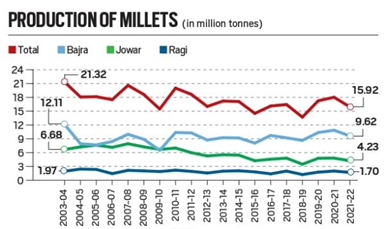The International Year of Millets: how India’s govt can promote the cereals in 2023
Context
The United Nations has declared 2023 as the International Year of Millets. Despite it having a lot to offer to consumers and farmers, millets aren’t the first choice.
What is Millet?
- Millet is a collective term referring to a number of small-seeded annual grasses that are cultivated as grain crops, primarily on marginal lands in dry areas in temperate, subtropical, and tropical regions.
- Examples: jowar (sorghum), ragi (finger millet), Kodo (Kodo millet), kutki (little millet), kakun (foxtail millet), Sanwa (barnyard millet), cheena (proso millet), kuttu (buckwheat) and chaulai (amaranth).
Positives of millets:
- Nutritionally superior traits: Millet’s score over rice and wheat in terms of minerals, vitamins, and dietary fibre content, as well as amino acid profile.
- For example, Bajra (pearl millet), has iron, zinc, and protein levels comparable to that of wheat, but it’s gluten-free and has more fibre.
|
- The rotis from bajra make one feel fuller for longer, as they take more time to digest and do not raise blood sugar levels too fast.
Advantages as a crop:
- Millets are hardy and drought-resistant crops.
- This has to do with their short duration (70-100 days, against 115-150 days for rice and wheat)
- lower water requirement (350-500 mm versus 600-1,250 mm) and
- ability to grow even on poor soils and in hilly terrain.
Where do millets lag?
- Eating Habits: For the poor, both in urban and rural areas, rice and wheat were once aspirational foods
- The dominance of traditional grains: Two-thirds of India’s population receives up to 5 kg of wheat or rice per person per month at Rs 2 and Rs 3/kg respectively.
- The recent move to place two fine cereals free of cost from January 2023, further tilts the scales against millets.
- Cooking: Rolling Rotis is easier with wheat than millet flour
- This is because gluten proteins make the wheat dough more cohesive and elastic.
- As resultant bread come out light and fluffy (in the case of wheat), which isn’t the case with bajra or jowar.
- Low per-Hectare yields: The national average is roughly 1 tonne for jowar, 1.5 tonnes for bajra and 1.7 tonnes for ragi.
- Whereas it is 3.5 tonnes for wheat and 4 tonnes for paddy — are a disincentive.
- Presence of Infrastructure for traditional grains: With access to assured irrigation, they would tend to switch to rice, wheat, sugarcane, or cotton.
- Absence of government procurement at minimum support price (MSP): It makes farmers hesitant to grow even this high-yielding and naturally bio-fortified bajra, suitable for both post-monsoon Kharif and summer cultivation.
|
Indian Agricultural Research Institute (IARI) contribution:
|
Possible Government Intervention:
- The Centre has two existing schemes:
- Pradhan Mantri Poshan Shakti Nirman and
- Saksham Anganwadi & Poshan 2.0 — with a combined budget of Rs 30,496.82 crore in 2022-23.
- These can be better leveraged by making them more millets-focused.
- MSP procurement of millets should be part of a decentralized nutritional programme specifically targeting tomorrow’s citizens.
- Centre could fund any state willing to procure millets specific to their region exclusively for distribution through schools and anganwadis.
Role of Schools:
- Every schoolchild and Anganwadi beneficiary can be served one daily hot meal based on locally-sourced bajra, jowar, ragi, Kodo, or kutki.
- It will help combat hidden hunger, besides giving a boost to crop diversification by creating demand for millions of small millets, dairy and poultry farmers.
State Initiatives:
- Odisha already has a dedicated millets mission that undertook procurement of 32,302 tonnes worth Rs 109.08 crore, mainly of ragi, in 2021-22.
- Rajasthan, Uttar Pradesh, and Haryana might want to do the same in bajra, just as Maharashtra may for jowar, Karnataka for ragi, and Madhya Pradesh for Kodo/ kutki.




